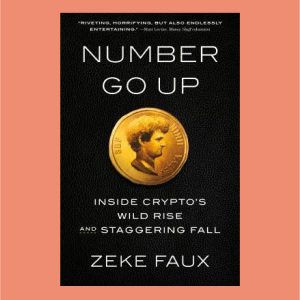By Steven Assarian, Business and Career Librarian
The story of cryptocurrency in the last decade has been wil d growth.
d growth.
We went from a niche idea being promoted by a few hobbyists to Matt Damon telling us to buy crypto while we watched the Super Bowl in almost the blink of an eye.
Today, crypto is a social, economic, and political juggernaut. We need to understand it in order to make sense of our current financial reality.
That’s why you should read Number Go Up: Inside Crypto’s Wild Rise and Staggering Fall by Zeke Faux.
Faux is a writer from Bloomberg News. In this book, he’s wading neck deep into the history and culture of cryptocurrency from a first-person, slightly gonzo perspective. It has an informal, snarky tone that might not be to everyone’s taste, but that snark is backed up by really thorough reporting that tells an important story.
It’s certainly a colorful tale. There’s a plastic surgeon who becomes a crypto mogul, a crypto influencer who uses stolen billions to further her (painful) rap career, and a party where Faux had to pay tens of thousands of dollars to buy a Mutant Ape NFT, which you get when you expose your Bored Ape from the Bored Ape Yacht Club to a vial of ‘mutant serum’.
(This, of course, is pretty terrifying; I don’t know how I’d tell my wife I was risking a college-fund level of money on a Mutant Ape.)
The main focus of the book, Sam Bankman Fried, was a crypto darling who crashed to earth when it was revealed that his crypto exchange, FTX, was a massive fraud. It’s in Faux’s access to Sam and his team that you get the most interesting parts of the book.
What you have here is an opportunity that’s all too rare in journalism: a lot of access to a famous or important figure with a journalist who’s still able to report on that figure with a skeptical eye.
Journalism that’s close to power often becomes fawning because the journalist needs to maintain the relationship with the powerful figure to maintain their access to that figure. In a real sense, their meal ticket relies on not being adversarial, or being adversarial in such a way that it doesn’t make anybody too angry. Faux seemed to avoid this trap and asked Sam hard questions when a lot of people were not.
I really enjoyed reading Faux’s writing about the skill that goes into his reporting. It’s rare that a journalist actually describes what exactly they do to find a signal in the noise, and we have a good, entertaining example of that here. He puts those skills to use exploring the darker, under-reported side of the crypto ecosystem in addition to its luminaries.
Faux actually travels to the Philippines to profile the normal people who bet their futures on a blockchain-based game called Axie Infinity and lose. He also goes to Southeast Asia, trying to find a cryptocurrency scammer that tried to defraud him, only to find what is essentially a forced-labor camp for crypto-scammers. These kinds of stories haven’t seen nearly as much reporting as the sky-high valuations that crypto assets have commanded in the past few years. What appears to us as numbers on a spreadsheet or ticker have real human costs.
For those readers that have been following the FTX collapse and the Sam Bankman-Fried trial, this book might be a bit of a retread of what you already know. But as someone who’s been following crypto for a few years, it’s really helpful to see all the different collapses, events, and consequences of crypto laid out in a narrative a reader can follow.
Because it turns out, as Matt Damon once told us, fortune doesn’t always favor the brave.
Especially if we hear about that fortune over a Super Bowl ad.

